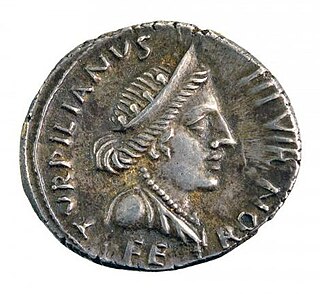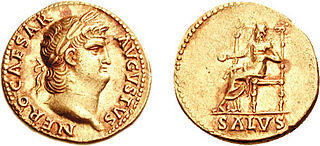Related Research Articles

Diana is a goddess in Roman and Hellenistic religion, primarily considered a patroness of the countryside and nature, hunters, wildlife, childbirth, crossroads, the night, and the Moon. She is equated with the Greek goddess Artemis, and absorbed much of Artemis' mythology early in Roman history, including a birth on the island of Delos to parents Jupiter and Latona, and a twin brother, Apollo, though she had an independent origin in Italy.

Jupiter, also known as Jove, is the god of the sky and thunder, and king of the gods in ancient Roman religion and mythology. Jupiter was the chief deity of Roman state religion throughout the Republican and Imperial eras, until Christianity became the dominant religion of the Empire. In Roman mythology, he negotiates with Numa Pompilius, the second king of Rome, to establish principles of Roman religion such as offering, or sacrifice.

In Roman religion, Angerona or Angeronia was an old Roman goddess, whose name and functions are variously explained. She is sometimes identified with the goddess Feronia.

Fontus or Fons was a god of wells and springs in ancient Roman religion. A religious festival called the Fontinalia was held on October 13 in his honor. Throughout the city, fountains and wellheads were adorned with garlands.

In ancient Roman religion, the diiNovensiles or Novensides are collective deities of obscure significance found in inscriptions, prayer formulary, and both ancient and early-Christian literary texts.
In ancient Roman religion, Sancus was a god of trust, honesty, and oaths. His cult, one of the most ancient amongst the Romans, probably derived from Umbrian influences. Cato and Silius Italicus wrote that Sancus was a Sabine god and father of the eponymous Sabine hero Sabus. He is thus sometimes considered a founder-deity.

Summanus was the god of nocturnal thunder in ancient Roman religion, as counterposed to Jupiter, the god of diurnal (daylight) thunder. His precise nature was unclear even to Ovid.
Nortia is the Latinized name of the Etruscan goddess Nurtia, whose sphere of influence was time, fate, destiny, and chance.

Neptune is the Roman god of freshwater and the sea in Roman religion. He is the counterpart of the Greek god Poseidon. In the Greek-inspired tradition, he is a brother of Jupiter and Pluto; the brothers preside over the realms of heaven, the earthly world, and the seas. Salacia is his wife.

In ancient Roman religion and myth, Janus is the god of beginnings, gates, transitions, time, duality, doorways, passages, frames, and endings. He is usually depicted as having two faces. The month of January is named for Janus (Ianuarius). According to ancient Roman farmers' almanacs, Juno was mistaken as the tutelary deity of the month of January, but Juno is the tutelary deity of the month of June.

Juno was an ancient Roman goddess, the protector and special counsellor of the state. She was equated to Hera, queen of the gods in Greek mythology and a goddess of love and marriage. A daughter of Saturn and Ops, she was the sister and wife of Jupiter and the mother of Mars, Vulcan, Bellona, Lucina and Juventas. Like Hera, her sacred animal was the peacock. Her Etruscan counterpart was Uni, and she was said to also watch over the women of Rome. As the patron goddess of Rome and the Roman Empire, Juno was called Regina ("Queen") and was a member of the Capitoline Triad, centered on the Capitoline Hill in Rome, and also including Jupiter, and Minerva, goddess of wisdom.

In ancient Roman religion and mythology, Tellus Mater or Terra Mater is the personification of the Earth. Although Tellus and Terra are hardly distinguishable during the Imperial era, Tellus was the name of the original earth goddess in the religious practices of the Republic or earlier. The scholar Varro (1st century BC) lists Tellus as one of the di selecti, the twenty principal gods of Rome, and one of the twelve agricultural deities. She is regularly associated with Ceres in rituals pertaining to the earth and agricultural fertility.

In Etruscan and Sabine religion, Feronia was a goddess associated with wildlife, fertility, health, and abundance, also venerated by the Faliscans and later adopted into ancient Roman religion. As the goddess who granted freedom to slaves or civil rights to the most humble part of society, she was especially honored among plebeians and freedmen. Her festival, the Feroniae, was November 13 during the Ludi Plebeii, in conjunction with Fortuna Primigenia; both were goddesses of Praeneste.

Egeria was a nymph attributed a legendary role in the early history of Rome as a divine consort and counselor of Numa Pompilius, the second king of Rome, to whom she imparted laws and rituals pertaining to ancient Roman religion. Her name is used as an eponym for a female advisor or counselor.
In ancient Roman religion, the Furrinalia was an annual festival held on 25 July to celebrate the rites (sacra) of the goddess Furrina. Varro notes that the festival was a public holiday (feriae publicae dies). Both the festival and the goddess had become obscure even to the Romans of the Late Republic; Varro notes that few people in his day even know her name. One of the fifteen flamines was assigned to her, indicating her archaic stature, and she had a sacred grove (lucus) on the Janiculum, which may have been the location of the festival. Furrina was associated with water, and the Furrinalia follows the Lucaria on 19 and 21 July and the Neptunalia on 23 July, a grouping that may reflect a concern for summer drought.

Saturn was a god in ancient Roman religion, and a character in Roman mythology. He was described as a god of time, generation, dissolution, abundance, wealth, agriculture, periodic renewal and liberation. Saturn's mythological reign was depicted as a Golden Age of abundance and peace. After the Roman conquest of Greece, he was conflated with the Greek Titan Cronus. Saturn's consort was his sister Ops, with whom he fathered Jupiter, Neptune, Pluto, Juno, Ceres and Vesta.

Salus was the Roman goddess of safety and well-being of both the individual and the state. She is sometimes equated with the Greek goddess Hygieia, though their functions differ considerably.
The gens Cosconia was a plebeian family at Rome. Members of this gens are first mentioned in the Second Punic War, but none ever obtained the honours of the consulship; the first who held a curule office was Marcus Cosconius, praetor in 135 BC.

The gens Procilia, sometimes written Procillia, was a minor plebeian family at ancient Rome. Members of this gens are first mentioned during the final century of the Republic, but few of them obtained any position of importance in the Roman state, and they are best known as a result of the historian Procillius, a contemporary of Cicero, whose work has been lost, but who was cited as a source by the Roman antiquarians.
References
- ↑ Varro Lingua Latina VI 13.
- 1 2 Cicero Ad Quintum fratrem 3, 1, 12.
- ↑ De Lingua Latina VI 13.
- ↑ G. Dumézil Fêtes romaines d'eté et d'automne Paris, 1975.
- ↑ Samuel B. Platner (and T. Ashby) A Topographical Dictionary of Ancient Rome, 1927 s.v.
- ↑ Cicero Ad Quintum Fratrem 3, 1.
- ↑ As observed by Dumézil[ citation needed ] and Georg Wissowa.[ citation needed ]
- ↑ Martianus Capella; Eyssenhardt, Francis (1866). Martianus Capella. PIMS - University of Toronto. Lipsiae : In aedibus B.G. Teubneri.